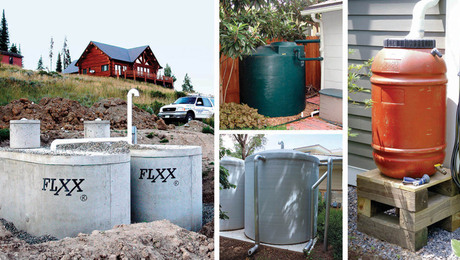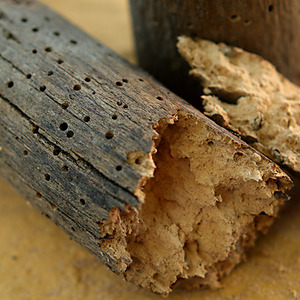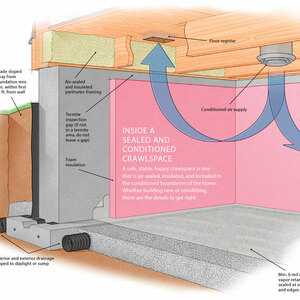Spraying icynene on staple up radiant
Hey there. Could someone tell me if its ok to have icynene sprayed directly onto a staple up radiant system, the kind with the plates? I am having my place done and before I do I would like to go ahead and put a staple up system under the bathroom floor since I already tiled it. But I remember reading somewhere that there ought to be an inch gap between the staple up and the insulation; however, this might have applied just to fiberglass batts. Oh well I cant wait to see what the prevailing consensus is 🙂
Handyman, painter, wood floor refinisher, property maintenance in Tulsa, OK


















Replies
What is the tube spacing?
Are the tubes plated for its entire length?
_________________________________
The air gap applied to non plated system to create consistent air temperatures across the floor joist to reduce the effect of thermal 'striping'.
With the plates (depending on spacing and 'population' of plates) it is not normally required.
RBean
http://www.healthyheating.com
http://www.healthyheating.com/blog
The tubes aren't put in yet. The joists are 24" apart and my thinking is to run the tubes two per joist (8" apart). Yes, I would plate the whole lenghth. Staple up doesn't seem to make much sense without plates but there are some instances where they can be. As far as I know the whole system will be plated. And I would prefer to do this before having the icynene put in. Now would be the best time to do it.Handyman, painter, wood floor refinisher, property maintenance in Tulsa, OK
I'm pretty sure you need the air space. Spraying insulation would not be my first choice. Maybe you could install rigid foam under the staple-up portion of your job and spray the rest.
The tubing should be spaced evenly... i.e. don't use 2 runs 8" apart per bay, as that leaves 16" between tubes from one bay to the next. You will definitely notice the thermal striping from above if they're that far apart. You might want three runs per bay instead.
What width of plate are you installing?
The narrower the plate the more I'm inclined to agree with David and recommend an air gap...horizontal condution for consistant surface temperatures is the objective...a wide plate would give you that...and less need for an air gap.
This is a good question...time to call in the experts...
Here's a link to an "alpha" source for plates (i.e. they hold several patents and make them for industry)... http://www.radiantengineering.com/Links/Finhomepg.html
Talk with Dale or Bob and tell them Robert Bean sent you.
Then come back and tell us what they said.
RBean
http://www.healthyheating.com
http://www.healthyheating.com/blog
Edited 1/28/2005 12:37 am ET by RB
A good place to talk radiant... better than here... go to heatinghelp.com and find the 'Wall' forum
the Wall is a good spot to 'Hang'.
David when you click the link below and slide down and over to the lower right hand side...you'll find an interesting piece on the Carlson - Holohan Industry Award of Excellence...( as in Dan -The Wall - Holohan ). Download the story...its interesting.
RBean
http://www.healthyheating.com
http://www.healthyheating.com/blog
Edited 1/28/2005 10:43 am ET by RB
Edited 1/28/2005 10:43 am ET by RB
Edited 1/28/2005 10:44 am ET by RB
Edited 1/28/2005 10:45 am ET by RB
Edited 1/28/2005 10:45 am ET by RB
Ok I see now where the logic is for an air gap. The plates I would use are 5" by 20". I suppose three per joist would be the best bet. I like the housewrap or foil cloth idea. If I were to do this I am leaning towards an air gap using foil faced iso foam. Then there would still be 4" depth of joist to fill with icynene. I am having my house done with icynene, all the perimeter walls, the vaulted ceiling, and the floors. Most of the floors are over an unconditioned crawlspace. The icynene guy and I considered just spraying the rim joist but its a vented crawlspace. So up under the floors it is. I can't wait to see the icynene in. Then I can see if what they say about it is true:)Handyman, painter, wood floor refinisher, property maintenance in Tulsa, OK
Seems like a very expensive insulation for interior use.
Is this over an unheated area? Sound control?
The icynene would expand into every crevice to wrap itself around the tubing and plates. I would suggest covering it with something to prevent this encapsulation at the very least. The first things that came to mind were tyvek or woven landscape fabric, because they are easier to work with than rigid materials or poly sheeting and do not tear easily.
Everything I've read said to give it air space.
Here's a nice graphic from our friends at Wirsbo...
Note: The spacing of 24" o.c joist and tubes at 8" o.c. is a concern...the graphic shows no air gap required but that's for 16" o.c. joist spacing and two tubes per space. I would say if you have really wide plates where there is less than 3" space between them you don't need the air gap...otherwise I would agree with the other posts and have a nominal 2" air space. By the way the air gap rule was established before the era of plates and was created so radiant reflective barriers could be used effectively and to prevent striping. Sometimes people will ask if you need to have an air barrier with topping (poured systems) ....the answer is no. The horizontal conduction and tube spacing takes care of the surface temperature consistencies.
View Image
A great site to see more of this stuff is http://www.wirsbo.ca or http://www.wirsbo.com
RBean
http://www.healthyheating.com
http://www.healthyheating.com/blog
Edited 1/28/2005 1:54 pm ET by RB
Edited 1/28/2005 1:58 pm ET by RB